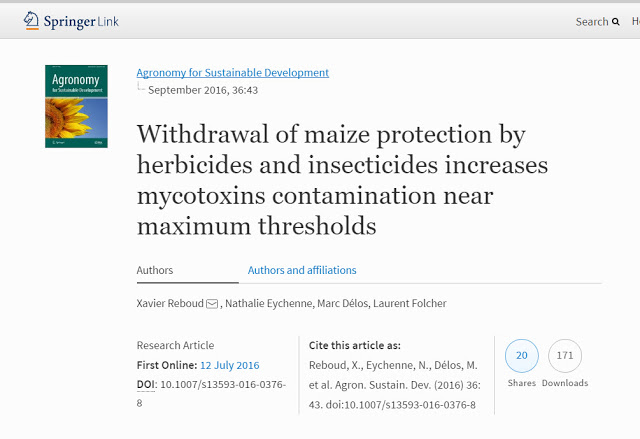

| Online: | |
| Visits: | |
| Stories: |

| Story Views | |
| Now: | |
| Last Hour: | |
| Last 24 Hours: | |
| Total: | |
High tech farming can produce safer corn with lower levels of dangerous chemical contaminents
Abstract
Environmental and economic issues affect decision-making for whether or not to control small infestations of pests and pathogens in crops. Even where no crop yield loss is expected, other risks may be evident, such as the slow accumulation of pathogen inocula. The prevalence of toxins, arising from biotic interactions with fungal diseases, can alter crop quality rather than quantity. Thus, farmer decisions for whether to tolerate pest infestation must take into account several direct and immediate and/or delayed potential risks. Published scientific evidence on the co-occurrence of risk factors resulting from the presence of different pests and pathogens are largely absent, and this has stifled the adoption of integrated pest management. Here, we tested how the withdrawal of herbicide and insecticide protection in maize, alone and in combination, might induce higher prevalence of up to 23 mycotoxins in the crop at harvest. The experiment was conducted over 4 years in 29 fields in the south west of France. The test involved a comparison of paired samples collected from treated and untreated plots. All nine major mycotoxins that were observed in more than 4 % of the samples showed highly variable concentrations both between fields and years. The overall trend following the cessation of pesticide protection, however, is for higher levels of mycotoxins and up to a six-fold increased in nivalenol mean concentration (to 202.3 μg kg−1 of maize seeds) compared to its treated control. Overall mycotoxin concentrations approached 55–67 % of their maximum acceptable rate, a situation of reduced security margin that could lead to economic penalties and market restrictions. We found that the removal of herbicides had a greater impact than that of insecticides on the prevalence of mycotoxins, which differs from the expectation stated in the literature. This finding is further reinforced by the observation that certain species of weeds harbor several species of Fusarium. This means that weeds not only play a role as crop competitors but also as reservoirs of inoculum in the field. Our findings illustrate the importance of sanitary evaluation when the implementation of new cropping systems will alter the distribution and occurrence of pests and pathogens.
KeywordsAgroecology Biotic interaction Risk assessment Pest control Fusarium Ostrinia nubilalis
Source: http://gmopundit.blogspot.com/2016/11/high-tech-farming-can-produce-safer.html



